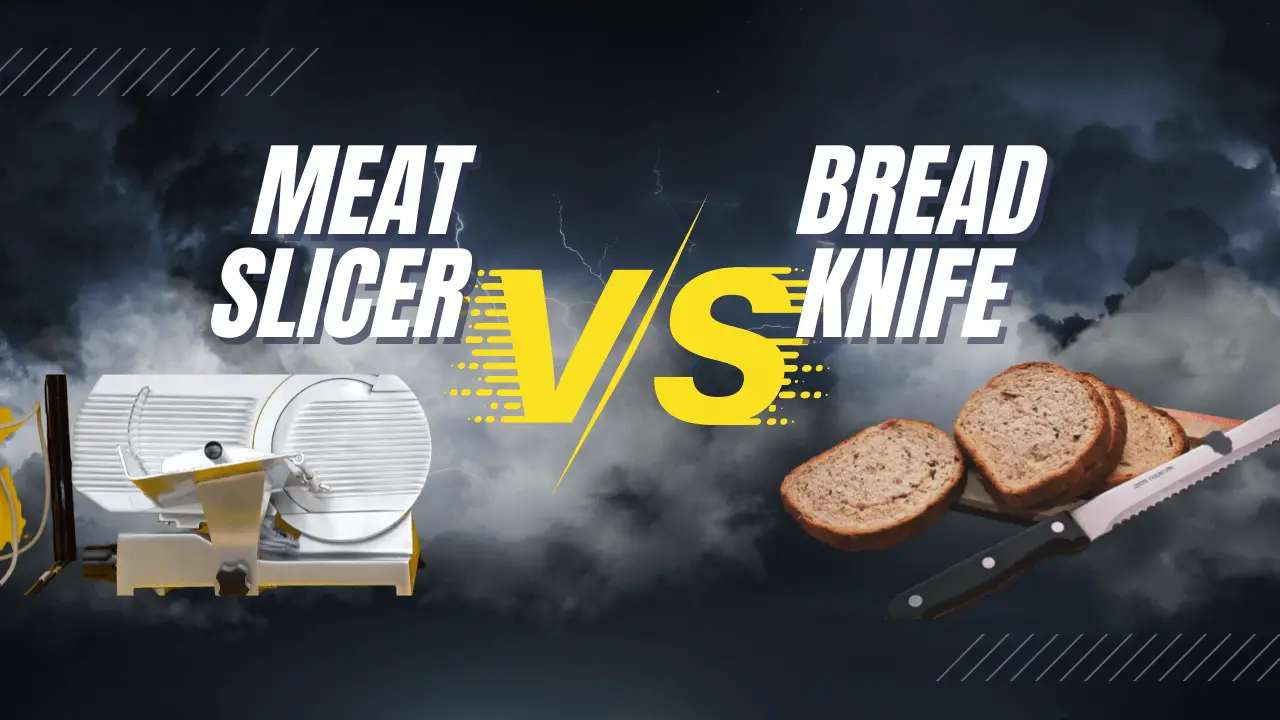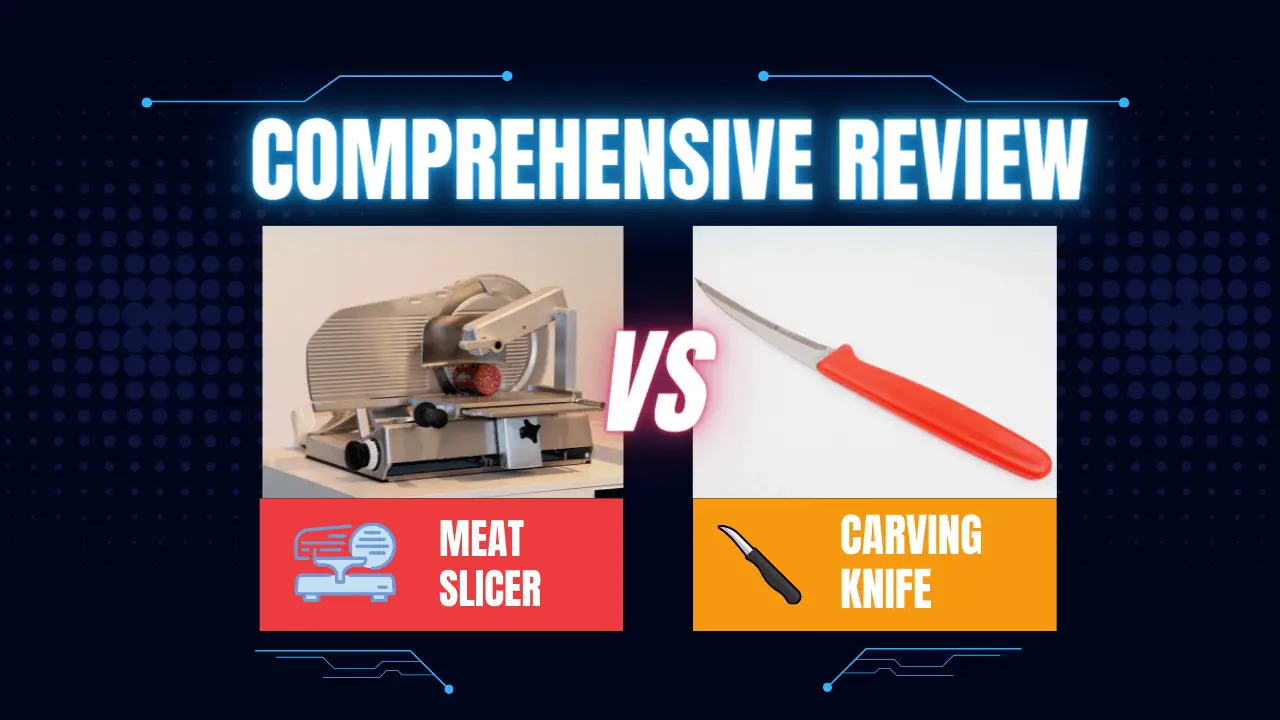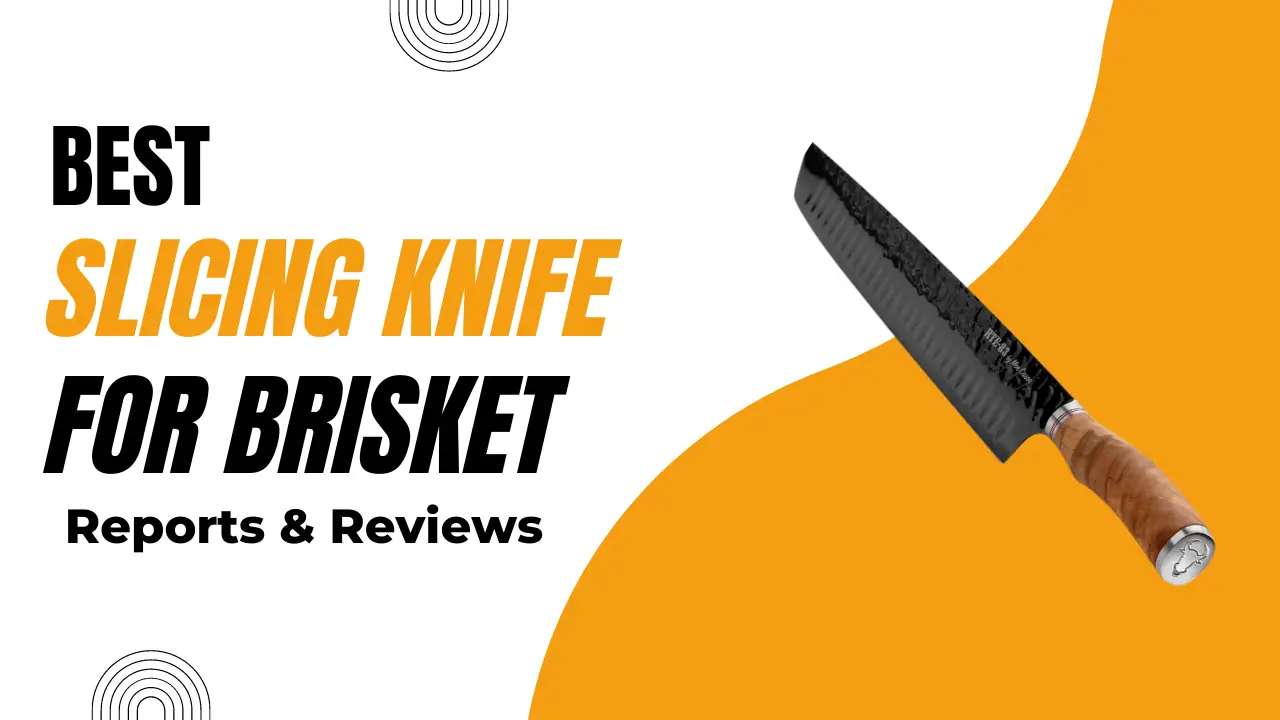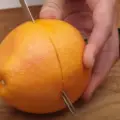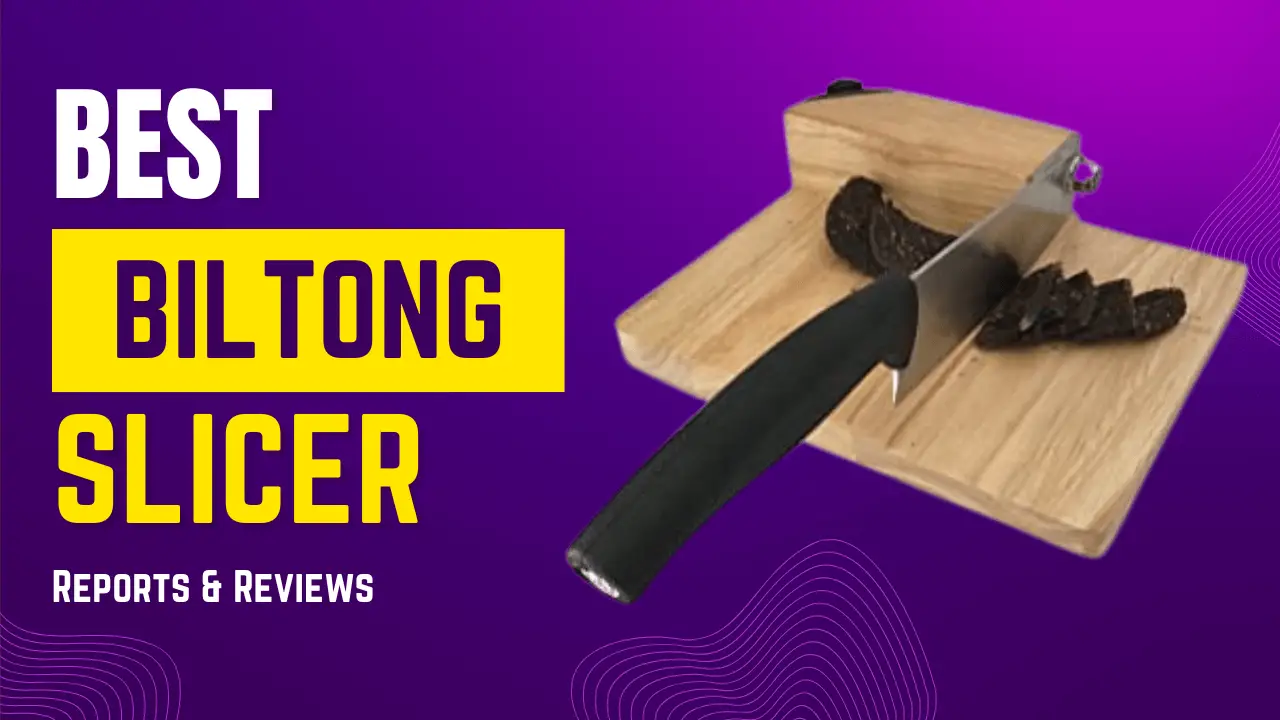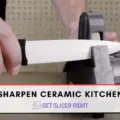The main difference between a slicer knife and a chef knife lies in their design and intended uses. A slicer knife is longer, narrower, and more flexible, making it perfect for cutting thin slices of meat, fruits, and vegetables. It offers precision and delicacy in slicing tasks. On the other hand, a chef knife is a versatile tool with a curved blade that can handle a variety of kitchen tasks, including slicing, dicing, and chopping. It’s a go-to knife for many different ingredients and offers versatility in the kitchen.
Slicer Knife: Precision Slicing at Its Best
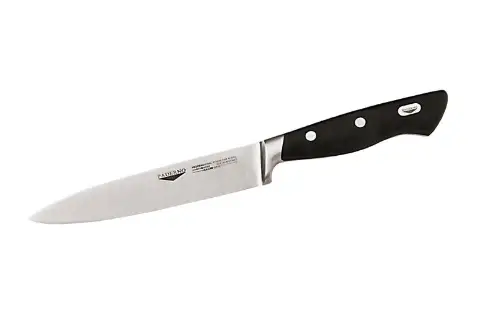
Overview:
Slicer knives are specifically designed for precise slicing, offering a range of features that make them perfect for delicate cuts of meat, fruits, and vegetables.
Blade Length:
Slicer knives typically have a longer blade length, ranging between 10 and 14 inches. This extended length provides ample reach, making it easier to cut through larger pieces of meat or fish with precision and control.
Tip Shape:
The tip of a slicer knife can be rounded or pointed, depending on personal preference and specific needs. The rounded tip is generally safer to use, reducing the risk of accidental punctures or cuts, while the pointed tip allows for more precise and intricate slicing techniques.
Flexibility:
One of the key characteristics of slicer knives is their flexibility. The blade is thinner and more flexible compared to other types of knives. This flexibility enables you to create thin, delicate slices of cooked meats, fruits, and vegetables without exerting excessive force or damaging the texture of the food.
Blade Thickness:
Slicer knives have a thinner blade, typically measuring between 0.30 and 0.35mm. The thinness of the blade allows for precise slicing without the need for excessive force. It ensures that each slice is clean, and uniform, and maintains the integrity of the food.
Granton or Scalloped Edge:
Many slicer knives feature a Granton or scalloped edge along the blade. These small hollowed-out grooves or indentations help reduce friction between the blade and the food being sliced. They also prevent the food from sticking to the blade, ensuring smoother and more effortless slicing.
Ideal Uses:
Slicer knives excel at cutting boneless cuts of meat, such as roast beef and poultry, into thin, even slices. They are also handy for slicing through other large pieces of meat, such as ham or brisket. Additionally, slicer knives are great for preparing fruits and vegetables, enabling you to create thin slices for salads, garnishes, or other culinary creations.
Chef Knife: The Versatile Kitchen Workhorse
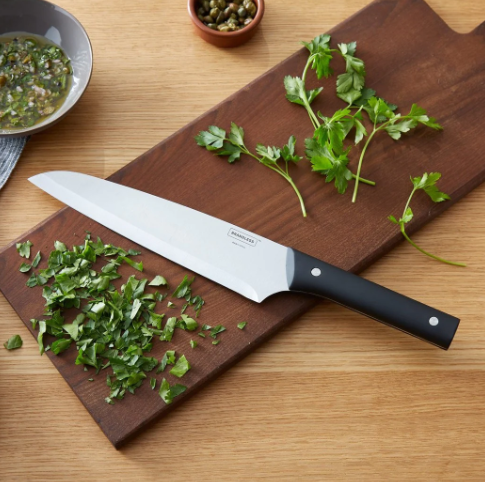
Overview:
Chef knives are widely regarded as the most versatile and essential tool in any kitchen. They offer a wide range of features that make them suitable for various kitchen tasks.
Blade Length:
Chef knives typically range from 6 to 12 inches in length, with the most popular size falling within the 6-8 inch range. Longer blades (10-12 inches) are favored by professional chefs for handling larger quantities of food and making longer cuts.
Blade Shape:
There are two common blade shapes for chef knives: French and German. French-style knives have a straighter edge until the end, where it curves up, allowing for a rocking motion while chopping. On the other hand, German-style knives have a continuous curve along the cutting edge, making them suitable for a more fluid slicing motion.
Versatility:
A chef knife is renowned for its versatility and can handle a wide range of kitchen tasks. It excels at slicing, dicing, and chopping various ingredients, including meats, vegetables, and herbs. Additionally, it can be used for tasks like crushing garlic with the flat side of the blade.
Blade Materials:
Chef knife blades can be crafted from different materials, each with its advantages. Common materials include carbon steel, stainless steel, laminate (a combination of different metals), and ceramic. Carbon steel offers excellent sharpness but requires more maintenance to prevent rust. Stainless steel provides durability and corrosion resistance. Laminate blades combine the best qualities of different metals, while ceramic blades offer exceptional sharpness but are more prone to chipping.
Handle Materials:
Chef knife handles are available in a variety of materials, including wood, steel, or synthetic/composite materials. The choice of handle material is subjective and should be based on personal preference, comfort, and grip. It’s important to choose a handle that feels secure and comfortable in your hand during prolonged use.
Technique:
Proper knife technique is essential when using a chef knife to ensure safety and precision. Many chefs prefer a “pinch grip” technique, where the thumb and index finger grip the blade itself, while the middle finger rests on the handle for stability. This grip offers better control, balance, and precision during cutting tasks.
Which Knife to Choose?
Now that we understand the characteristics of both the slicer knife and the chef knife, now consider the factors and also summarize their ideal uses to help you decide which knife suits your needs:
Cutting Style:
If you frequently work with boneless cuts of meat or need to slice thin pieces, a slicer knife is a way to go. On the other hand, if you require a versatile knife that can handle a variety of tasks, a chef knife is a better choice.
Blade Length:
Consider the size of the ingredients you typically work with. For smaller cuts, an 8-inch chef knife will suffice. If you often deal with larger cuts or need to process more food at once, a longer chef knife or a slicer knife may be more suitable.
Blade Flexibility:
If you need a knife that can easily maneuver around bones or make delicate, precise slices, the flexibility of a slicer knife will be advantageous. However, if you prefer a sturdier blade for heavier tasks, a chef knife is a better option.
Personal Preference:
Ultimately, the choice between a slicer knife and a chef knife comes down to personal preference and the specific tasks you frequently perform in the kitchen. Consider the feel and comfort of the knife in your hand to ensure a good grip and control during cutting.
Slicer Knife Ideal Uses:
- Cutting small and thin slices of meat, fish, fruits, and vegetables.
- Slicing roasts, ham, or brisket.
- Working with boneless cuts.
- Preparing salads, sandwiches, and stir-fry dishes.
Chef Knife Ideal Uses:
- Chopping, dicing, and slicing a wide variety of ingredients.
- Cutting meat, fish, and vegetables.
- Chopping herbs and nuts.
- Performing versatile kitchen tasks.
FAQ: Frequently Asked Questions
Can I use a slicer knife for everyday kitchen tasks?
While a slicer knife is primarily designed for the precision slicing of meat and delicate foods, it can certainly be used for everyday tasks like cutting vegetables and fruits. However, for more versatile use, a chef knife would be a better choice.
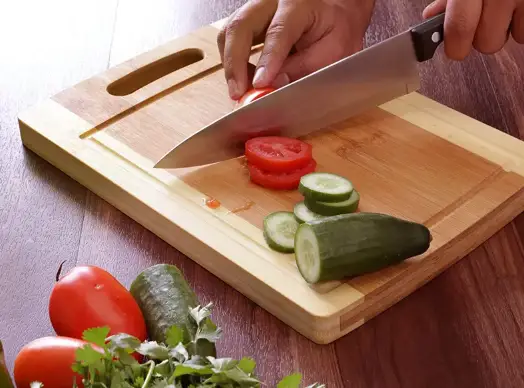
Which knife should I choose if I’m a beginner in the kitchen?
As a beginner, a chef knife is a great all-around tool that will serve you well in most kitchen tasks. Its versatility and ease of use make it a favorite among home cooks and professionals alike.
How should I care for my knives to ensure their longevity?
Proper knife care involves hand washing, drying immediately after use, and storing them in a knife block or magnetic strip. Regular honing and occasional sharpening are also crucial to maintain their sharpness.

Can a chef’s knife be used for slicing meat?
Yes, a chef knife is a multipurpose tool that can handle slicing tasks, including meat. However, slicer knives offer more flexibility and precision for thin slices.
Are slicer knives more difficult to maintain compared to chef knives?
Not necessarily. Both slicer knives and chef knives require proper maintenance to keep them sharp and in optimal condition. However, the specific maintenance requirements may vary depending on the blade material.
Conclusion:
Choosing between a slicer knife and a chef knife depends on the specific task at hand. Slicer knives excel in precision slicing, making them ideal for delicate cuts of meat, fruits, and vegetables. On the other hand, chef knives are versatile workhorses that can handle a wide range of kitchen tasks, from slicing and dicing to chopping and crushing. By understanding the unique features and uses of each knife, you can confidently select the right tool to enhance your culinary skills.
Key Takeaways:
- Slicer knives are designed for precision slicing of meat, fruits, and vegetables, with a longer, thinner, and more flexible blade.
- Chef knives are versatile, all-purpose tools that excel at slicing, dicing, and chopping, with a range of blade lengths and shapes.
- Slicer knives are ideal for boneless cuts, while chef knives can handle a wide variety of kitchen tasks.
- Both knives require proper care and maintenance to ensure longevity and performance.
Pros And Cons, Similarities And Differences:
| Slicer Knife | Chef Knife | |
|---|---|---|
| Pros | – Ideal for slicing thin cuts of meat, fish, fruits, and vegetables. | – Versatile for a wide range of kitchen tasks. |
| – Longer, thinner blade provides flexibility for delicate slicing. | – Curved edge allows for a rocking motion while chopping and dicing. | |
| – Scalloped edge reduces friction, allowing for smoother slicing. | – Can handle meat, fish, vegetables, herbs, and nuts. | |
| – Well-balanced and ergonomic handle for non-slip and comfortable grip. | – Can be used for crushing garlic with the flat side of the blade. | |
| – Durable and easy to hand wash. | – Available in various blade lengths and handle materials. | |
| Cons | – Limited versatility compared to a chef knife. | – Blade may be too wide for precise slicing of thin cuts. |
| – Not suitable for tasks that require chopping or dicing. | – Can be heavier and harder to maneuver for untrained users. | |
| – May not handle tougher cuts of meat or bone-in pieces. | – Requires proper maintenance to retain sharpness and avoid corrosion. | |
| – Scalloped edges may not be suitable for all slicing needs. | – Longer blades may require more skill and practice to handle efficiently. | |
| Similarities | – Both knives can be used for slicing meat, fish, fruits, and vegetables. | – Both knives are essential tools in any kitchen. |
| – Both knives require proper maintenance to retain sharpness. | – Both knives come in various blade lengths and handle materials. | |
| – Both knives offer a comfortable grip for safe and precise cutting. | – Both knives can be sharpened when needed. | |
| – Both knives contribute to efficient and enjoyable cooking experiences. | – Both knives are made with high-quality materials for durability. | |
| Differences | – Slicer knives are specifically designed for thin-slicing tasks. | – Chef knives are versatile and can handle a wide range of tasks. |
| – Slicer knives have longer and thinner blades for flexibility. | – Chef knives have shorter and wider blades for versatility. | |
| – Slicer knives often have a scalloped edge for smoother slicing. | – Chef knives have a curved edge for rocking motion while cutting. | |
| – Slicer knives are ideal for boneless cuts. | – Chef knives can handle meat, fish, vegetables, herbs, and nuts. |
References And Citations:
Here are some suggested external links:
- Knife Skills:https://cooking.nytimes.com/guides/23-basic-knife-skills How to Slice Like a Pro
- The Difference Between Slicing and Carving Knives https://www.mashed.com/336431/the-major-difference-between-carving-knives-and-slicing-knives/
- Choosing the Right Chef’s Knife https://www.cuisineathome.com/articles/how-to-choose-a-chefs-knife/
- Knife Maintenance and Sharpening Tips

John Hebdon is a food enthusiast, passionate chef, and author of various articles and blog posts related to food and cooking. With a deep love for all things culinary, John’s blog serves as a platform to share his extensive kitchen experiences with a broader audience.
In addition to his culinary expertise, John has a flair for writing and a natural ability to share his passion for food with others. His articles and blog posts are informative, engaging, and packed with practical tips for readers of all skill levels.
As a food enthusiast and writer, John is always on the lookout for new and exciting culinary experiences. Whether it’s trying out a new restaurant, experimenting with a new recipe, or simply sharing a favorite dish with friends and family, John is always eager to explore and share the world of food with others.

